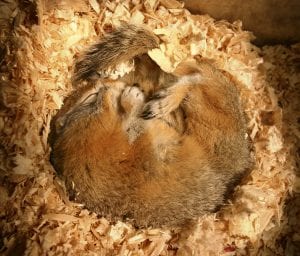Ira Pastor, ideaXme exponential health ambassador and founder of Bioquark, interviews Professor Dr. Kelly Drew from the Department of Chemistry and Biochemistry, Institute of Arctic Biology, University of Alaska, Fairbanks (UAF).

Ira Pastor comments:
Today we are going to move into a fascinating area of biology that has potential applications across various domains of human health and enhancement, and that is the area of hibernation biology.
Hibernation is defined as a state of inactivity and metabolic depression in endotherms (defined as warm-blooded animals capable of internal generation of heat) and refers to a season of heterothermy (physiological term for animals that vary between self-regulating their body temperature, and allowing the surrounding environment to affect it) characterized by low body-temperature, slow respiration and heart-rate, and low metabolic rate.
It most commonly occurs during winter months, often associated with low temperatures, and functions to conserve energy when sufficient food is unavailable. Hibernation may last days, weeks, or months depending on the species, ambient temperature, time of year, and the individual’s body-condition.
Hibernating animals, such as Arctic ground squirrels and black bears, undergo unique changes in their metabolism and these changes allow animals to survive long periods of reduced activity and body temperature with no health problems.

Fascinatingly, during hibernation, brain temperature in organisms like the arctic ground squirrel drops to just above freezing, its core body temperature reaches temperatures down to 2.9°C (26.8°F), its heart rate drops to about one beat per minute, and peripheral, colonic, and blood temperatures become subzero, yet they don’t develop ice crystals, allowing their body fluids to remain liquid while in super cooled state.
Human Hibernation: Possible Applications
Understanding these metabolic adaptations of hibernation could reveal ways to treat certain human health problems, such as atrophy in unused and aging muscles, obesity, type 2 diabetes and cardiovascular diseases.
Additionally, the ability of humans to learn from these neuroprotective skills of such organisms and one day be able to pseudo-hibernate would be useful for saving the lives of seriously ill following strokes, brain traumas or other catastrophic injuries. Needless to say, this ability not to form ice crystals could lead to much better preservation of human organs and tissues for transplant.
Dr. Kelly Drew
To go further into this area, we are joined today by Professor Dr. Kelly Drew, from the Department of Chemistry and Biochemistry, Institute of Arctic Biology, University of Alaska, Fairbanks (UAF).
Dr. Drew holds a BS in psychology from the University of Alaska, a PhD in Neuropharmacology from Albany Medical College, and was a postdoctoral fellow in Neuropharmacology at the Karolinska Institute, Stockholm.
Dr. Drews lab focuses on three aspects of hibernation biology. The first involves mechanisms of intrinsic neuroprotective properties of Arctic ground squirrel brain in the hibernating and euthermic (normal warmed) state.
The second involves mechanisms and cognitive significance of synaptic remodeling observed during hibernation torpor (inactivity) and arousal.
The third involves central nervous system regulation of metabolic suppression in hibernation.
Dr. Drew was the driving force behind a new five-year, $11.8 million National Institutes of Health grant to help University of Alaska scientists translate their knowledge of hibernating animals into treatments that advance human health.
Dr. Drew has been the recipient of many awards, including the UAF Dennis Demmert Award for supporting Native and Rural

students, the Emil Usibelli Distinguished Teaching Award for her ability to recognize scientific aptitudes in underrepresented students, The NIH Sidney A McNairy, Jr. Mentoring Award, and Dr. Drew also was nominated for the NSF Presidential Mentoring Award.
Drew, who grew up in Fairbanks, is an Alaskan putting Alaska on the innovation map as she contributes to global advances in biomedical research
On this show we will hear from Dr. Drew:
About her background, how she became interested in health, pharmacology, and how she finds herself at the epicenter of the fascinating domain of hibernation biology research. We’ll learn about the thermolytic process and her work with Adenosine-1 Receptor agonism and antagonism for potentially inducing and reversing thermolytic effects in humans. A discussion of the amazing neuroprotection found in the Arctic ground squirrel following thermolytic state and how it may hold on to memories even after brain remodeling. Finally, we’ll look toward the future and the possible application of these tools in areas like organ preservation and transplantation.

Credits: Ira Pastor interview video, text, and audio.
Follow Ira Pastor on Twitter: @IraSamuelPastor
If you liked this interview, be sure to check out our interview exploring the Human-Animal connection for health and wellness!
Follow ideaXme on Twitter: @ideaxm
On Instagram: @ideaxme
On YouTube: ideaxme
Find ideaXme across the internet including on iTunes, SoundCloud, Radio Public, TuneIn Radio, I Heart Radio, Google Podcasts, Spotify and more.
ideaXme is a global podcast, ambassador and mentor programme. Our mission: Move the human story forward!™ ideaXme Ltd.

Pingback: Blood for Everyone! - ideaXme Ambassador Interviews
Pingback: Discover Biology At The Extreme Limits of Life - ideaXme
Pingback: Living Architecture: Merging Living Systems With Buildings - ideaXme